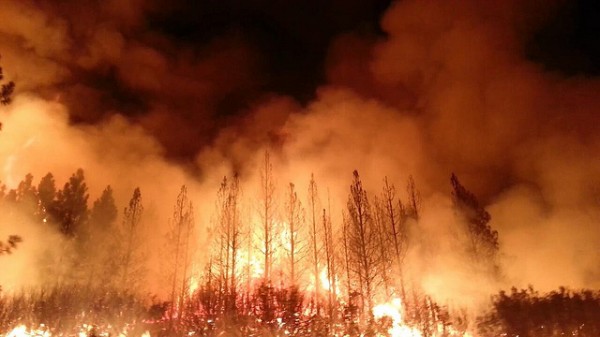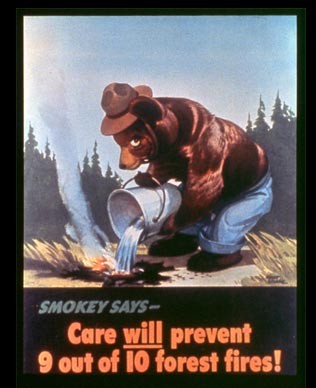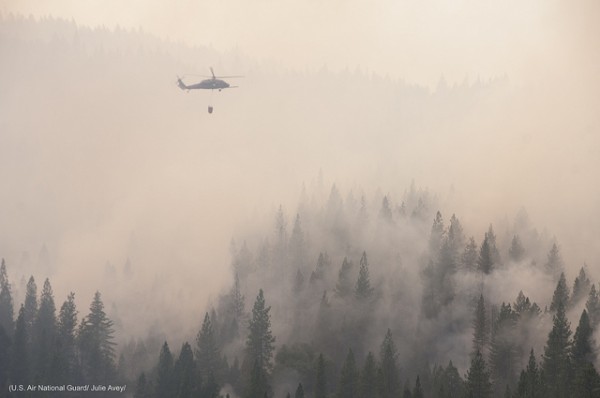The Rim Fire raging in California near Yosemite National Park and the water reservoir for much of San Francisco and Silicon Valley residents, is now one of the largest in California’s recent history.
Dramatic media stories usually dwell on what’s currently happening with fire fighting efforts, but little ink is spent looking at the suite of issues that can make forest fires bigger, faster and more dangerous to people and our nation’s treasured forests.

1. Industrial logging has increased fire risk
Industrial logging has dramatically increased fires and fire risk by removing large commercially-valuable trees — the very trees which are the most resistant to fire, and which create shade. Logging older trees and opening up the forest canopy makes things hotter and drier, and more prone to fire. The sticks and wood leftover from logging, called “slash,” often remain behind for years on the ground like kindling. Industrial logging also requires roads. Many thousands of old, unneeded logging roads riddle our National Forests, serving as super-highways for flammable, invasive weeds. In addition, these roads increase accidental and intentional human fires in our forests. The legacy of tax-payer subsidized logging on our public lands and industrial logging on private lands has left us with a mess that will take many generations to fix.
Solution: Re-focus the Forest Service and Bureau of Land Management away from subsidized industrial logging to ecological restoration and preventative fire safety.
2. Smokey the Bear was wrong
A “put out every fire” approach to wildland fire management for decades has left us with a fire deficit which can fuel unusually big, hot fires. Many forests in the West have “skipped” fires that normally would have occurred due to overly-aggressive fire suppression. Ecologically speaking, these forests need to burn, as they have for thousands of years, to sustain a cycle of life, death and renewal. We need to protect people and property, but extinguishing every wildland fire only, well, backfires over time.
Many of the “catastrophic” fires referenced by media are quickly forgotten…years later (see Yellowstone and the Biscuit fire in Oregon’s Siskiyou National Forest) things are far from catastrophes. There are a whole host of things fires do for forests to keep them healthy, and to fuel the cycle of life, death and regeneration that sustained forests for thousands of years before Europeans showed up. That fire suppression was strongly supported by the timber industry whose PR spokespersons now, ironically, call for more aggressive logging to remedy the mistake they helped perpetrate on our forests for decades.
Solution: Prioritize fire-fighting to protect human lives and property; don’t risk the lives of firefighters and waste taxpayer money on fires that are not threats to communities. Leave fire-affected forests alone to allow for natural regeneration — don’t “kick the forest while it’s down” with post-fire logging.
3. Smokey the Bear was (sorta) right

No matter how hot or dry, forests don’t spontaneously burst into flames. An ignition source is needed to get a fire going. In nature it’s really only lightning strikes that serve as ignitions. However, humans are really good at starting fires in a wide variety of ways, even at times of years when natural ignitions would rarely occur (such as extreme droughts when lightning storms are relatively rare). Humans are so good at starting fires that more than 80 percent of wildland fires in the American West are ignited by people.
Solution: Reduce human-caused fire ignitions by closing and removing unneeded logging roads, continue public education efforts (we can agree on this, Smokey).
4. Fire-fighting has changed — and it now involves a lot more burning

Forest fire fighting has evolved over time based on technology, science and, perhaps most importantly, politics. The federal government’s approach to fire once was one of full-on direct attack — an approach that is costly and dangerous. Now, an informal policy known as back off and backfire” dominates. The decision to back off and backfire may be right or wrong, but the fact is that backfires are now a significant percentage of total fire size. Simply put, the US now has a fire fighting strategy that involves making a lot more fire happen. The Rim Fire’s total size, regularly reported by the media, never includes an acknowledgement that some of the “fire” is actually the “fire fighting.” And, the ecological effects of backfires are only starting to be evaluated.
Solution: The federal government should track and report the difference between “real” fires and backfires (aka “suppression fires”). The government should also fund ecological studies of the effects of backfires to better inform fire suppression and forest management over time.
5. The US government is not properly budgeting fire-fighting
Headlines about the Forest Service running out of money to fight fires are plentiful, but the source of this predictable, annual problem, are rarely examined. Strangely, preparedness for federal fire-fighting is not treated in the same way responses to other federal emergencies. That results in constant short-falls, leaving the Forest Service no choice but to raid budgets for important forest management, restoration and public service programs to give heroic fire fighters the resources they need to battle blazes. In fact, the Forest Service is currently in the process to siphon $600 million from such programs to fire fighting efforts. This is a long term lose-lose for fire fighting and taxpayers.
Solution: Set up a properly funded, dedicated budget for fire-fighting that is tiered to scientific fire forecasts. Create a long-term solution for fire suppression funding that treats wildland fires like other federal emergencies.
6. Climate change can make all the problems humans have created worse.

Though it is difficult to point to any fire and say “climate change” there is broad scientific consensus that global warming will bring hotter, drier conditions to the American West, and set the stage for more extreme fire events. This, combined with decades of unsustainable logging, road-building and fire suppression could push forests beyond their capacity to deal with fire. Though the remaining stately sequoias in Yosemite have thrived alongside fires for thousands of years, taken together, climate change and other human impacts may prove too much.
Solution: Save carbon-rich forests and create an Energy (r)Evolution now to prevent out-of-control climate change, including bigger, more dangerous fires in the future.
7. Development
Part of the sky-rocketing cost of wildland fire fighting has resulted from expanded human development into what once was remote, fire-prone landscapes. With more homes and buildings in hot-zones, there is more need for aggressive fire fighting when fires do take place. Just as building in a flood-plain or seismically-active area, homes and human infrastructure in fire-prone areas should be built and maintained with fire safety in mind.
Solution: Be smart about development, and be fire-safe. Prioritize prescribed burns and mechanical fuel removal in and around communities where it will do the most good. Fully fund these efforts, and don’t cannibalize them for fire fighting. Prevention is worth much more, in terms of forest health, fire-fighter safety and taxpayer dollars, than desperate last-ditch fire fighting.



